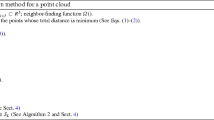Abstract
The output of close range photogrammetry is a finite set of 3D points which causes generating a discrete space. The dataset is a point cloud with no defined topology and structure. For diagnosing disease precisely using close range photogrammetry, specifically in an intelligent manner, it is necessary to reconstruct and parameterize a continuous and topology-definable surface from the measured points. Traditional methods for surface reconstruction such as interpolation and using approximation functions do not provide topological information and required details for shape analysis and disease diagnosis. According to SOM abilities for reconstruction of the space of measured points as a fully structured and topology-definable surface, in this research, a medical system has been designed and implemented by integration of SOM and close range photogrammetry. The research result shows that SOM is an effective tool for recognizing the pattern of measured points and generating a reference surface around affected areas. So, close range photogrammetry and SOM can be used to develop integrated systems as two complementary techniques for diagnosing diseases whose symptoms are visible or appear as deformations out of body and around the affected area.








Similar content being viewed by others
References
Atkinson KB (2001) Close range photogrammetry and machine vision. Whittles Publishing, Scotland
Mitchell HL, Newton I (2002) Medical photogrammetric measurement: overview and prospects. ISPRS J Photogramm Remote Sens 56(5–6):286–294
Majid Z et al (2005) Photogrammetry and 3D laser scanning as spatial data capture techniques for a national craniofacial database. Photogram Rec 20(109):48–68
Remondino F (2004) 3-D reconstruction of static human body shape from image sequence. Comput Vis Image Underst 93(1):65–85
Normando D, Lima da Silva P, Mendes ÁM (2011) A clinical photogrammetric method to measure dental arch dimensions and mesio-distal tooth size. Eur J Orthod 33(6):721–726
Boersma SM et al (2000) Photogrammetric wound measurement with a three-camera vision system. ISPRS, Amsterdam
Farnood Ahmadi F, Layegh NF (2014) Integration of close range photogrammetry and expert system capabilities in order to design and implement optical image based measurement systems for intelligent diagnosing disease. Measurement 51:9–17
Wen-Chang C (2006) Neural-network-based photometric stereo for 3D surface reconstruction. In: International joint conference on neural networks. IJCNN ‘06
Lin W-C, Chen S-Y, Chen C-T (1989) A new surface interpolation technique for reconstructing 3D objects from serial cross-sections. Comput Vis Gr Image Process 48(1):124–143
Xu M, Tang Z, Deng J (1995) A B-spline surface interpolation technique for reconstructing 3d objects from serial arbitrary shaped planar contours. In: Chin R et al (eds) Image analysis applications and computer graphics. Springer, Berlin, pp 74–82
Kellman PJ, Garrigan P, Palmer EM (2011) 3D and spatiotemporal interpolation in object and surface formation. In: Tyler CW (ed) Computer vision: from surfaces to 3D objects, in computer vision: from surfaces to 3D objects. CRC Press, Taylor & Francis Group, New York, pp 183–207
Chia-Wei L, Medioni G (1994) Surface approximation of a cloud of 3D points. In: Proceedings of the 1994 2nd CAD-based vision workshop
Park H, Kim K (1995) An adaptive method for smooth surface approximation to scattered 3D points. Comput Aided Des 27(12):929–939
Nior ADMBJ, Neto AODDR, Melo JDD (2004) A self-organized neural network for 3D surface reconstruction. In: WSEAS, Italy
Kohonen T (2011) Self-organizing maps, 3rd edn. Springer, New York
Chong AK (2009) New developments in medical photogrammetr. Geoinf Sci J 9(1):41–50
Tokarczyk R, Mazur T (2006) Photogrammetry—principles of operation and application in rehabilitation. Med Rehabil 10(4):30–39
Sechidis L, Tsioukas V, Patias P (2000) An Automatic process for the extraction of the 3D model of the human back surface for scoliosis treatment. In: International archives of photogrammetry and remote sensing, Amsterdam
D’apuzzo N, Mitchell H (2008) Medical applications. Table of contents for advances in photogrammetry, remote sensing, and spatial information: 2008 ISPRS congress book 2008. CRC Press, New York
Kohonen T et al (1996) Engineering applications of the self-organizing map. Proc IEEE 84(10):1358–1384
Self organizing maps—applications and novel algorithm design: InTech. 702
Barhak J, Fischer A (2002) Adaptive reconstruction of freeform objects with 3D SOM neural network grids. Comput Graph 26(5):745–751
Author information
Authors and Affiliations
Corresponding author
Rights and permissions
About this article
Cite this article
Farnood Ahmadi, F. Close range photogrammetry and self-organizing map for automatic diagnosing diseases. Neural Comput & Applic 27, 1883–1891 (2016). https://doi.org/10.1007/s00521-015-1980-2
Received:
Accepted:
Published:
Issue Date:
DOI: https://doi.org/10.1007/s00521-015-1980-2




